|
NOTWITHSTANDING witchcraft
being made a capital crime both by the civil and canon law, the Old Church
does not appear to have used much exertion either in tracing it out or in
its prosecution. Strange to say, the influence of the Reformation—the
general effect of which was to dissipate darkness and remove superstition
—had, so far as the imaginary crime of witchcraft was concerned, a different
tendency. When the priest remained careless, and, perhaps, incredulous, as
to the obscure workings of the deeds of darkness, the presbyter of the New
Church considered it his duty to expiscate and clear out even to the
cleansing by fire rumoured delinquencies, in the exercise of magical arts.
In Scotland this feeling was intensified in the Reformed Church by the Act
of Queen Mary, 4th June, 1563, passed within three years after the downfall
of the Roman establishment. This Act was no doubt inspired by the zeal of
the Reformers to purge the country of diabolical influences. It seems,
however, not to have been called much into requisition until after the
return of James VI. from his matrimonial expedition to Denmark in 1591. The
revelation of unholy practices against the Lord's anointed in the course of
that memorable voyage, and after his return, threw the timorous King into a
state of terror, and inspired him with the desire, as a sovereign prince, to
exterminate the practisers of devilish arts from his dominions. Not only did
he encourage prosecutions, but he wrote a book to prove the reality of the
crime the credibility of which had been impugned by the catholic Weir. From
1591 to the death of King James, in 1625, thirty-five trials for witchcraft
appear in the Justiciary records, and from that date down to 1640 only eight
trials are recorded. From 1640 to 1660 there were thirty trials, although
under the Commonwealth the judges generally discouraged such prosecutions,
After the Restoration the
prosecutions fur witchcraft greatly increased, and in the year immediately
following 1661 not fewer than twenty persons were condemned to death for
witchcraft before the High Court of Justiciary, and, in addition, instead of
the cases being brought before the ordinary criminal courts, Circuit and
Justiciary, commissions were also granted by the Privy Council to
understanding gentlemen, empowering them to deal with the cases of reputed
witchcraft occurring in the special loca iljes with which they were
connected. On one single day—7th November, iu6i—not less than fourteen
commissions were granted, and during the first eight months of the following
year fifty additional commissions, each of them containing from one to ten
names of reputed witches. The reports of these Commissions have not been
preserved, but the recorded executions alone during 1662 are stated at not
less than one hundred and fifty in number.
One of the most fruitful in
the number of executions resulting from its investigations was that granted
in favour of Mr Alexander Colville of Blair, His Majesty's Justice Depute
for Scotland, under whose presidency five trials were held in the parish of
Fossoway, within the ancient Stewartry of Strathearn. From the proximity of
the scenes of the alleged malefices and the place of the trial and execution
to Auchterarder, it has been resolved to include the record of them in this
historical collection.
These trials took place at
the Crook of Devon. For a number of years suspicions of witchcraft were
entertained, and that of practisers of unholy arts being resident in the
Ochils and their southern boundaries. The case of John Brugh, who resided in
Fossoway, and who exercised his arts in the adjoining parishes of Glendevon
and Muckhart, was still fresh in the memory of the terrorised inhabitants.
The persons brought to trial before the Justice Depute, Mr Alexander
Colville of Blair, the same judge who presided at the trial of Alexander
Drummond in 1629, were thirteen in number, consisting of one warlock, Robert
Wilson, and twelve witches; and as thirteen formed a "covin," or company of
witches—a "deil's dozen," it is supposed that the Commission had for its
ultimate object the eradicating of the whole gang. Of the thirteen, only one
of them, Agnes Pittendriech, escaped, which she owed to being pregnant at
the time of her trial, and being respited under an obligation to come up
again for trial when required. As there is no record of any ulterior
proceedings being taken against her, it is to be hoped that her respite
resulted in their ultimate withdrawal. In the case of Margaret Hoggan no
conviction or sentence against her is recorded, although the evidence
against her was equally strong as against the other panels; but in the
dittay against her she is described as a woman of threescore and nineteen
years, and she may have been either spared on account of her old age, or she
may have died in the excitement and terror in the course of her trial. She
is referred to as deceased at the next diet of Court, which took place two
months after wares. Christian Grieve was put to her trial in July, 16C2, and
although the evidence against her appears to have been strong, the "hail
assize in one voice declare that they will not convict her in no point of
witchcraft, nor clenze her in no point," and yet within a period of three
months the same jury, under the same presiding judge, and apparently without
any additional evidence, convicted her, and she was strangled and burnt on
the fifth day thereafter.
As appears from the Records,
the Court sat at the Crook of Devon. It met on five different
occasions—viz., 3rd and 23rd of April, 1662; 5th May, 1662; 21st July, 1662;
and 8th October, 1662. On the first of these trials Agnes Murrie, Bessie
Henderson, and Isabella Rutherford were condemned, and strangled and burnt
on the following day. On the second occasion Robert Wilson, Bessie Neil,
Margaret Lister, Janet Baton, and Agnes Brugh were found guilty and
sentenced to be burnt on the following day, Agnes Fittendriech being
respited on account of her pregnancy. At the third diet, Margaret Hoggan and
Janet Paton were brought to trial. As before stated, there is no conviction
against Margaret Hoggan; but Janet Paton was sentenced and strangled and
burnt the same day. At the next diet two prisoners were brought to
trial—Janet Brugh and Christian Grieve. The former was convicted and
executed the same day, but Christian Grieve was acquited. She was, however,
re-tried and convicted by the same jury on the 8th October following, and
burnt on the 13th. These sentences were carried into execution at a place
called the Lamblairs, bewest the Cruick Miln.
As appears from the Records,
the juries were formed of men of position, and in various instances the
surnames which were then identified with the different properties and
localities remain identified with them still. It will be also seen from the
Records that the principal heritor of the parish— the Laird of Tullibole,
assisted by his Bailie and the ministers of Fossoway, Kinross, Cleish, and
Muckhart, were instrumental in getting up the prosecutions and extorting
confessions and admissions from the accused. It may be noticed that two of
the accused bore the same name as John Brugh, whose trial is narrated
above—viz., Agnes Brugh, in-dweller in Goosclands, and Janet Brugh, spouse
to James Morries, at the Crook of Devon. It is likely that these women were
related to him.
We do not know from the
Records of any such wholesale holocaust of witches in Scotland as took place
at the Crock of Devon. The account is a dreadful one, and shows what an
amount of credulity and terror had seized upon the inhabitants of this
country parish, with many of whom the victims must have been related by ties
of blood. While persons of consideration in Fossoway and the adjoining
parishes evinced their ardour in the prosecution, there was no difficulty in
getting men to carry the executions into effect by strangling and burning
the accused. No fewer than three are named in the trials as having acted as
dompsters—viz., William Donaldson, Alexander Abernethy, and Thomas Gibson,
and the executions were in all probability carried into effect by the same
men who pronounced the doom.
The original record of the
Court held at the Crook of Devon is not now believed to be in existence, but
the following transcript is made from an authenticated copy of the
proceedings, which belonged to the late Mr Henry Flockhart of Annacroich,
who had procured the document from the Rev. Mr Harvey, minister at Muckhart.
It was contributed with an interesting introduction by Robert Burns Begg,
Esq., Sheriff Clerk of Kinross-shire, to the Transactions of the Society of
the Antiquaries of Scotland, and we are indebted to that gentleman for the
privilege of its present reproduction.

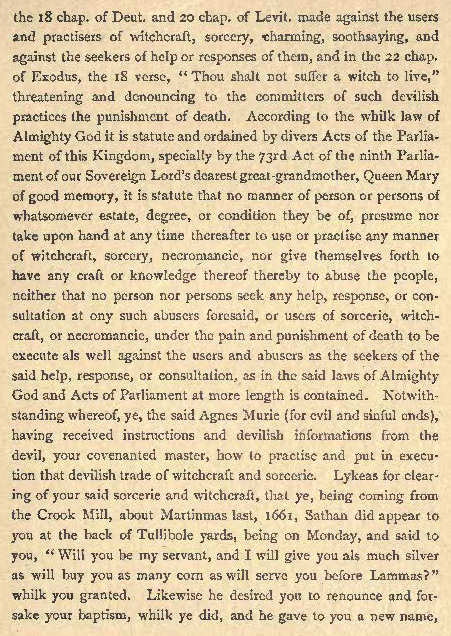



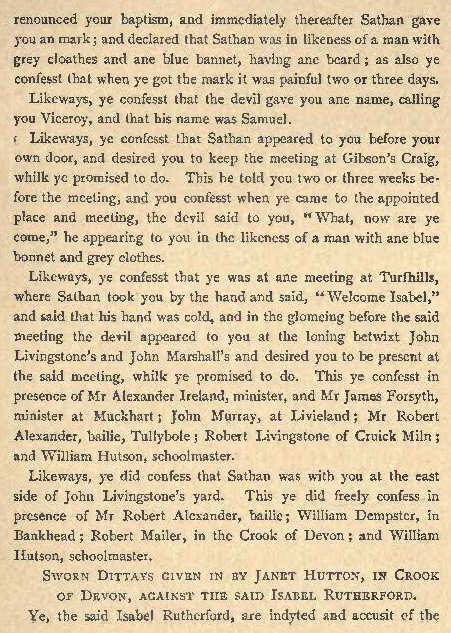

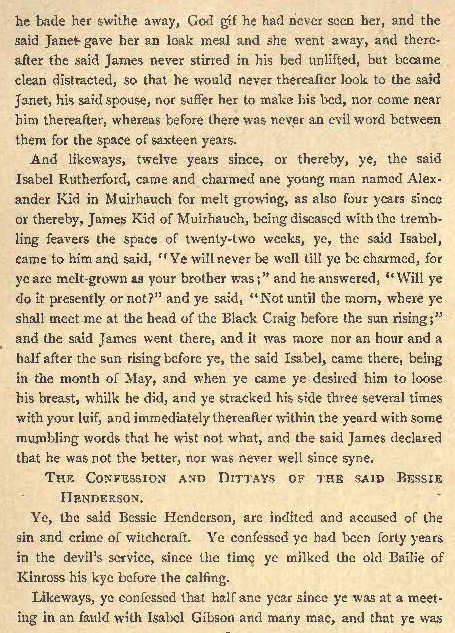






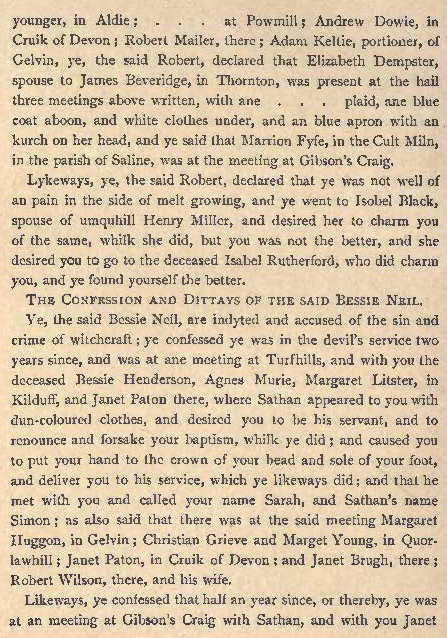

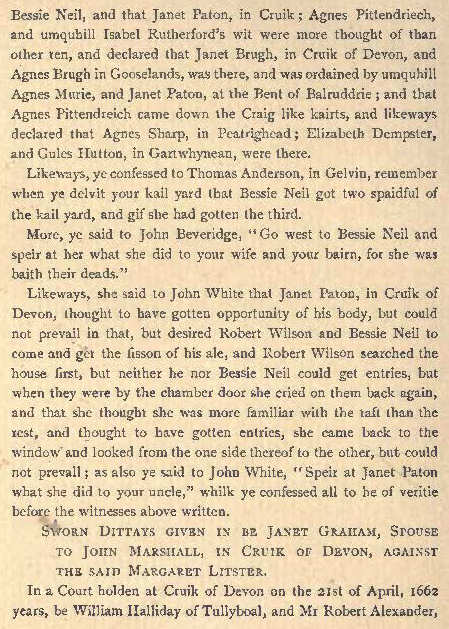


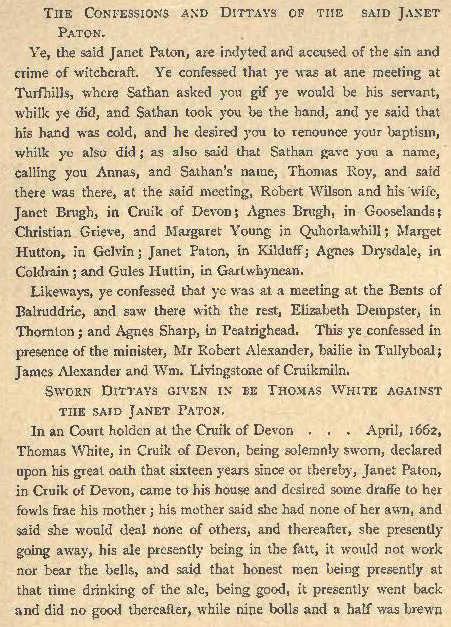


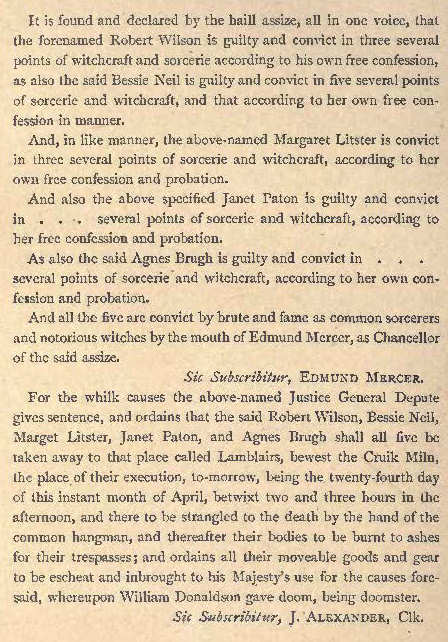
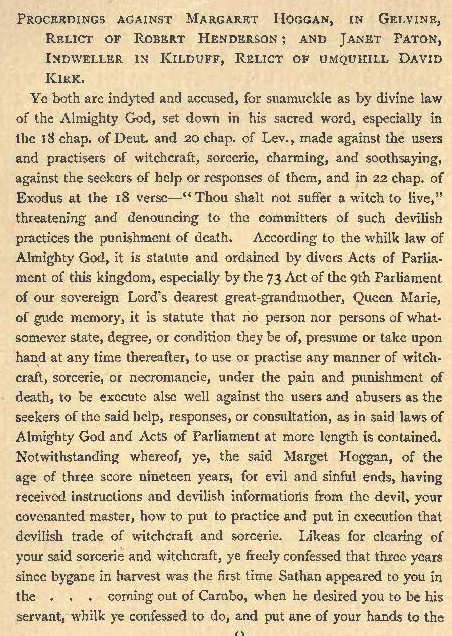
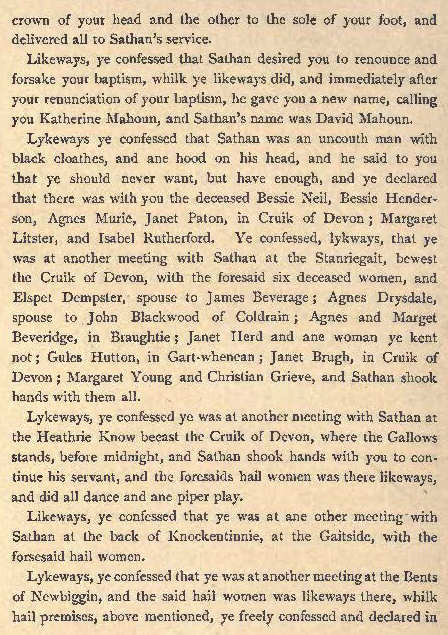
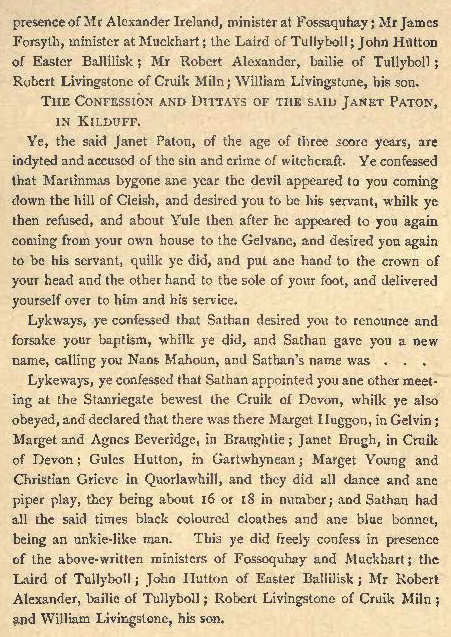

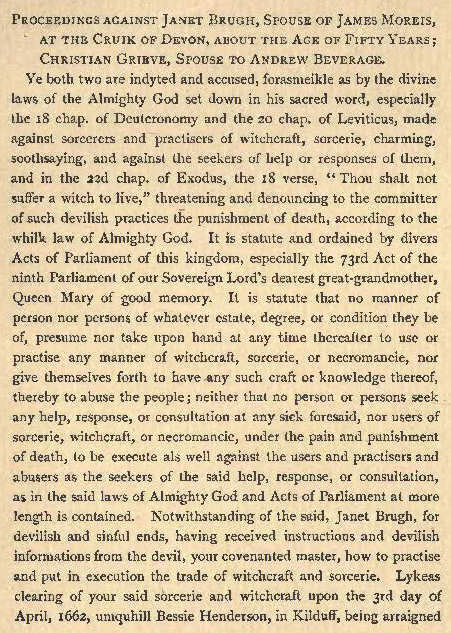



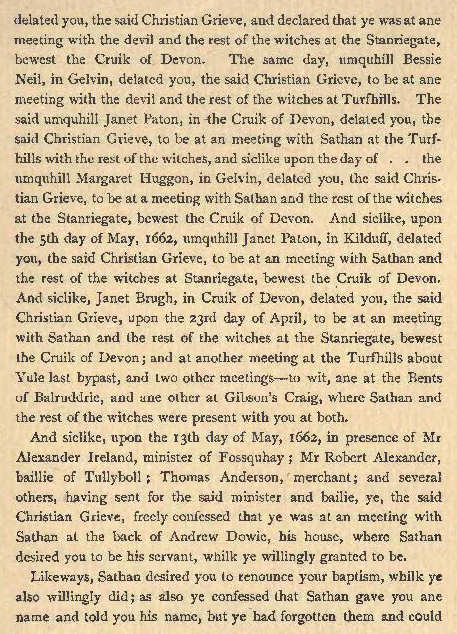

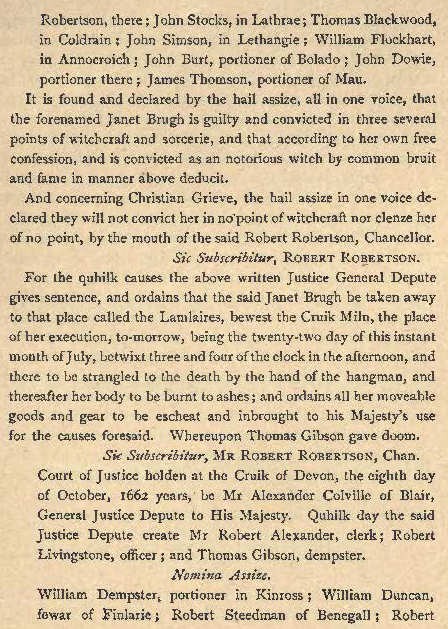
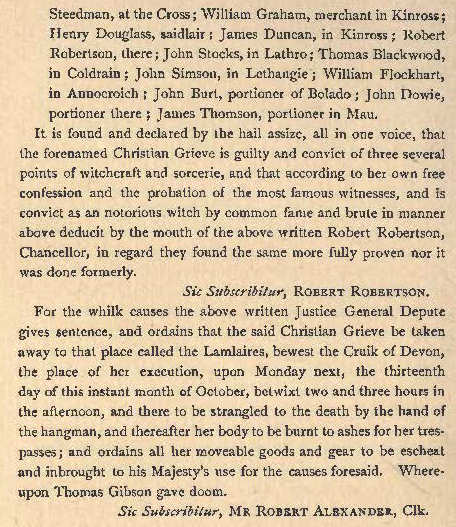
|

